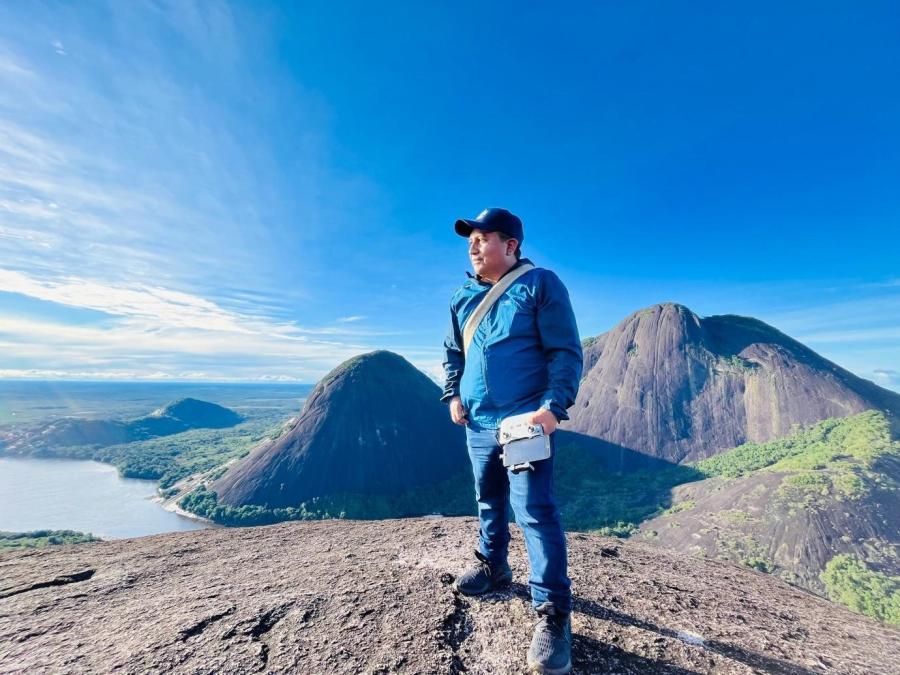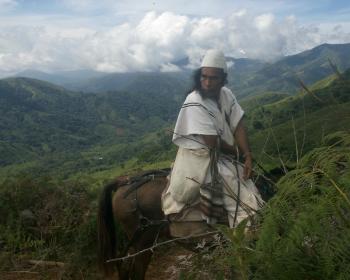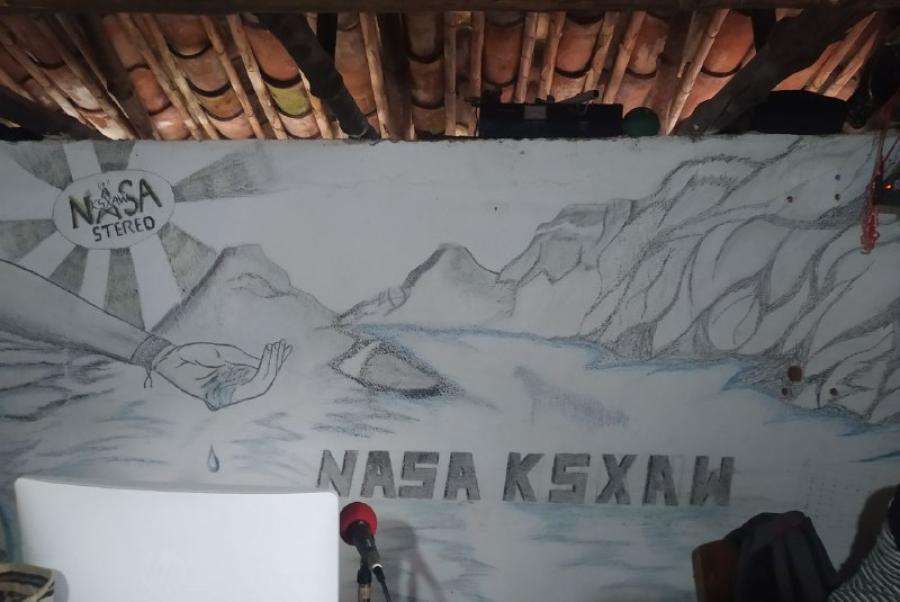Awa-Coaiquer Land and Resources Management Project
Who and where on earth are the Awa-Coaiquer Indians? Such questions would have remained largely unanswered, even in Ecuador and Colombia, but for an article in the Sunday color supplement of Quito, Ecuador's El Comercio printed in early 1982. Part of the explanation is geographic; the people live in dispersed settlements that span the Ecuador-Colombia border along the isolated western slopes of the Andes amidst the world's wettest tropical rainforest. The frontier is a politically established obstacle which the Awa frequently cross-unimpeded.
Solitude and obscurity for these Indians, however, reflects their good fortune. Neither their land nor its resources has been coveted or expropriated by large landowners; their territory has not been the target of national development. In addition, although the Colombian guerrilla movement M-19 dramatically escaped across the Rio Mira (part of Awa-Coaiquer territory, see map) several years ago, the region's inaccessibility and relative desolation have attracted neither permanent guerrilla groups nor cocaine traffickers, unlike the Amazonian Region of Colombia. In fact, the Awa were virtually unknown even to leaders of either Ecuador's national Indian organization, CONACNIE (Consejo Nacional de Coordinación de las Nacionalidades Indígenas del Ecuador) or Colombia's ONIC (Organización Nacional Indígena de Colombia). At present, however, the Awa-Coaiquer are involved in an international land tenure and resource management project which, while directly aiding only one society and a unique tropical rainforest "refuge" area, could serve as a model for indigenous human rights and natural resource management.
Because isolation does not last for long, work on the project is essential. As early as 1980, the World Bank was rumored to be considering a loan to Ecuador for the construction of a road which would penetrate the Tobar Donoso section of Carchi Province, i.e., through the middle of Awa territory. Such a project would undoubtedly bring with it an influx of colonists and land speculators (colonization has already been increasing on the Colombian side of the border). In July 1983, regional representatives from 13 Ecuadorian government agencies established the Inter-Institutional Commission for the Development of the Tobar Donoso area. One of the first activities planned was to demarcate an Awa-Coaiquer Indian Reserve.
Since Cultural Survival had supported a preliminary demarcation study with the Awa in 1980, the Inter-Institutional Commission requested funds for the project from CS. Although the project clearly fell within Cultural Survival's priorities, the organization was unable to provide direct support to a consortium of government agencies. At the suggestion of Cultural Survival and through the efforts of project advisor James Levy (now consultant for Ecuador's Ministry of Foreign Relations and CONACNIE) and supportive individuals within the Ministry of Foreign Relations (Carlos Villareal and Dr. Patricio Zuquilanda), a fourteenth member of the commission was added - CONACNIE. As a private, non-profit Indian organization, it was a logical recipient of Cultural Survival support. Equally important, the administrative responsibility linked an Indian organization directly to the implementation of the project, bringing those Indians most aware of government institutions and policies into contact with the least politically experienced group in the country.
In September 1984 Cultural Survival agreed to provide support to: 1) aid the Awa-Coaiquer and the Ecuadorian Agrarian Reform Agency (IERAC) in demarcating and titling traditional Awa land (approximately 80,000 hectares); 2) obtain citizenship identification certificates for the adult population and thus permit their right to land ownership; 3) assist CONACNIE in establishing closer links with Awa communities; 4) provide logistical aid to CONACNIE and other support groups involved in training sessions aimed toward informing the Awa of their rights within the national society and developing a panethnic organization to exercise these rights; and 5) provide modest indemnification for agricultural production introduced onto Awa lands by colonists. The overall goal of the first phase of this project was simply to obtain legal title to the land Awa communities already use.
As of early 1986 IERAC teams had formally surveyed all but a small, isolated sector of Awa territory. All colonists had been removed, and in March 1985 the national Registro Civil sent a special brigade into Awa territory for the first time and distributed citizenship cards to more than 1,100 Awa-Coaiquer. In March 1983, members of all 11 previously unorganized communities in the region met and elected the Awa's first cabildo (governing council).
The cabildo later formally affiliated itself with CONACNIE, which subsequently elected one cabildo member to CONACNIE's national directorate. Since then the cabildo has worked to obtain official corporate status (personería jurídica) for each Awa community, and thus gain the required formal recognition to deal directly with government institutions. IERAC and the Ministry of Foreign Relations have been the most active supporters of these initiatives.
In three years, Awa Indian communities, the national Indian organization, and several government agencies have peacefully collaborated and successfully obtained land for one of the nation's smallest and most isolated tribal societies. With limited outside technical assistance, coordinated primarily by other Indians, the Awa have organized themselves into a political entity essential for the defense of their territory.
Meanwhile, as government teams aided by Awa assistants were surveying the westernmost border, they encountered other Awa communities in the remote rainforest of Esmeraldas Province. Subsequently, a delegation of Awa Indians, CONACNIE representatives, officials from the Ministry of Foreign Relations and James Levy met with community members to request that the project be extended to include their territory as well. Having received official statements from national and provincial officials guaranteeing that a project would be carried out in Esmaraldas in a manner similar to that in Carchi, Cultural Survival approved support to extend the project to the entire Ecuadorian Awa community.
Obtaining title and establishing a local political body to defend it is an important step toward cultural survival; guaranteeing permanent land tenure is another matter. Land that outsiders perceive as "idle" (i.e., not put to some obvious economic use) becomes a coveted parcel and an easy target once outsiders learn of its existence. In order to prevent confiscation of "idle" land, a management scheme or "development" project is essential.
The Awa have already taken the first steps toward this end in order to protect their territory; a botanical research team from the University of Aarhus (Denmark) undertook the first botanical survey of the area. Although the survey produced no development plan, the research indicated that, similar to Colombia's Choco rainforest area, Awa territory is, by and large, ecologically undisturbed, and contains a wide variety of species whose distribution is limited to this particular area. Thus the area can be considered a "refuge zone," (i.e., one of several "islands" of tropical forest which remained as tropical forest during the driest period of the Pleistocene).
Such refuge zones are considered extremely important research areas and, for that reason alone, it has been recommended internationally that they remain unmodified. Such arguments buy essential time for the local population to consider and develop a program of sustainable forest use and management, rather than simply concede to national development priorities that usually lead to extensive deforestation and cattle raising. To avoid such an ominous future, the Awa, CONACNIE, and their advisors have begun to seek assistance in designing and establishing a sustainable resource management plan, once final land title is obtained.
Ecuador and Colombia Agree to Discuss Project
Since the Awa-Coaiquer population spans the Colombia-Ecuador border, the idea of extending this project into Colombia was mentioned informally to Colombian officials, who expressed considerable interest. Fortunately, the diplomatic mechanisms for formalizing this interest were already in place. The Office of Frontier Affairs of the Ministries of Foreign Relations, both of Colombia and Ecuador, meet regularly. Thus an April 1985 meeting in Bogotá was planned for the Joint Commission on Ecuadorian-Colombian Amazonian Cooperation. The Commission agreed to put on the agenda the issue of binational cooperation to aid the Awa-Coaiquer, and established a special working group to handle the details.
The possibility of extending the Awa project in Ecuador was enhanced by the fact that the work in Colombia would not have to begin from scratch. Since July 1982, Colombia's Fundación para la Educación Superior (FES) and the World Wildlife Fund- have maintained a nature reserve. La Planada, on land near Colombian Awa communities. La Planada, a 1,667-hectare land holding contains mainly unmodified tropical rainforest, characterized by high species diversity and remarkable floral and faunal endemism. Sitting almost across the border from the Awa Reserve in Ecuador, La Planada is primarily a research station. One of La Planada's manager's major concerns, however, is colonization, which although limited at the moment, is expanding, and future development (i.e., clearing of adjacent forest) could threaten this unique ecological niche. The dilemma, therefore, is to extend the area of La Planada's influence beyond the confines of the small experimental station. Thus, a secondary aspect of the La Planada program is to integrate natural resource conservation and management with economic development of the surrounding communities, many of which are presently populated by Awa-Coaiquer Indians. Consequently, the research director at La Planada prepared and presented a plan to the regional natural resources management agency to establish a biosphere reserve that would encompass approximately 280,000 hectares along the southern border of the department of Nariño - an area that abuts the Ecuadorian Awa Reserve.
In brief, the desired ends of both projects are nearly identical - a combination of Indian landholdings and a broad resource and management program to protect their habitat. Moreover, the needs in each country complement each other - whereas the Ecuadorian project began as an extensive Indian land reserve and political organization project and is now concerned with a land use program, the Colombian project. La Planda, was initially a resource management project, but later began to develop the sort of social mechanisms which now exist among the Awa of Ecuador.
Advised of the planned binational meeting, the World Wildlife Fund sent Cultural Survival a strong letter of support to expand the project and offered World Wildlife Fund's collaboration. The letter was forwarded to both Ecuador and Colombia's Ministry of Foreign Relations as well as the non-governmental organizations already involved in the project (i.e., FES and CONACNIE).
Working Group Presents Recommendations for Binational Cooperation
Advancing the project required only a positive decision by the respective Ministries of Foreign Relations and a plan. In this sense the Bogotá meeting of the Joint Commission (April 21-25, 1986) aided the work considerably. Both ministries responded enthusiastically to the project, and authorized a "Working Group for Binational Cooperation in the Preservation and Support of the Awa-Coaiquer." This group, in turn, presented a formal document to the meeting's proceedings, stating: the Third Working Group has studied the feasibility of undertaking activities of coordination and cooperation aimed at [the Awa-Coaiquer] population and concluded that, as well as being possible, such activities would respond to the interest of the two countries and to the underlying interests of binational integration and frontier development.
The working group also made the following recommendations to the Joint Commission:
1) Establish a mechanism for coordination directed toward promoting binational cooperation with the idea of maintaining the integrity of Indian culture and the environment which they inhabit, and improve their standard of living.
2) To realize these ends, the General Directorate of National Sovereignty of the Ecuadorian Ministry of Foreign Relations and the Division of Frontier Affairs of the Colombian Ministry of Government will coordinate the establishment of a binational technical meeting to identify and plan activities of mutual interest in this program. Such activities will include both the exchange of information and visits by technicians and advisors from the two countries.
3) Each country will identify the organization charged with implementing, in their respective countries, the proposed actions and programs during the planned binational technical meeting.
4) Upon request of all groups involved, international sources of financial and technical assistance will be identified, with the aim of carrying out activities of mutual interest.
The document also included agreements to exchange publications and to train students to work on the project. In contrast to the paternalism that characterizes much pro-Indian work in the Americas, the working group recommended that "with regard to the training courses which will be carried out with this Indian group in both countries, there will be participation by Indian [organizations] from Ecuador as well as Colombia" (Ibid). In this respect, both ONIC and CONACNIE were formally advised and informally consulted about the project and their anticipated participation.
Commission Approves Binational Project
As a first step the Commission recommended the demarcation and titling of Indian land, combined with a census, socio-economic study and other research of interest to both countries and their respective Indian populations. Following the Commission's meeting, Cultural Survival met with FES officers to outline the project's progress to date and to discuss possible collaboration. FES responded enthusiastically, offering both logistic and on-site facilities as well as the possibility of financial aid and technical assistance through a respected Indian support group, CECOIN (Centro de Cooperación al Indígena), which is collaborating with numerous Indian communities and federations in Colombia. Likewise, the World Wildlife Fund is considering supporting the project as part of its newly initiated "Wildlands and Human Needs Program."
In summary, although this project is still in the planning stages, the outlook is extremely promising. The foreign ministries of both countries, under whose jurisdiction frontier affairs lie, have approved the project, not merely in principle but in terms of such critical details as land demarcation and direct incorporation of Indian communities. Various other government agencies have expressed formal support for the project and a willingness to collaborate. Finally, national and international non-governmental agencies concerned with both Indian rights and national resource management have expressed strong approval of the project and have offered financial and technical assistance.
As the binational project evolves it will serve as an example of international frontier collaboration with regard to Indian rights and the controlled development of fragile ecosystems. It will also allow international agencies that share these goals to realize them in a collaborative and supportive manner by linking them to both government agencies and Indian organizations. Most important, the project will demonstrate that Indian human rights, resource conservation and national economic development are compatible when combined in a program that is sensitive to the needs of all affected groups.
Article copyright Cultural Survival, Inc.




